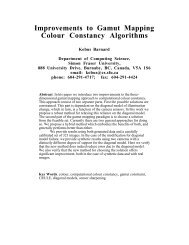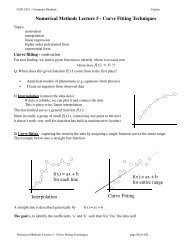50 1. INTRODUCTIONtion (1.92) and the corresponding entropy (1.93). We now show that these definitionsindeed possess useful properties. Consider a random variable x having 8 possiblestates, each of which is equally likely. In order to communicate the value of x toa receiver, we would need to transmit a message of length 3 bits. Notice that theentropy of this variable is given byH[x] =−8 × 1 8 log 128 = 3 bits.Now consider an example (Cover and Thomas, 1991) of a variable having 8 possiblestates {a, b, c, d, e, f, g, h} for which the respective probabilities are given by( 1, 1, 1, 1 , 1 , 1 , 1 , 1 ). The entropy in this case is given by2 4 8 16 64 64 64 64H[x] =− 1 2 log 212 − 1 4 log 124 − 1 8 log 128 − 1 16 log 2116 − 464 log 2164 = 2 bits.We see that the nonuniform distribution has a smaller entropy than the uniform one,and we shall gain some insight into this shortly when we discuss the interpretation ofentropy in terms of disorder. For the moment, let us consider how we would transmitthe identity of the variable’s state to a receiver. We could do this, as before, usinga 3-bit number. However, we can take advantage of the nonuniform distribution byusing shorter codes for the more probable events, at the expense of longer codes forthe less probable events, in the hope of getting a shorter average code length. Thiscan be done by representing the states {a, b, c, d, e, f, g, h} using, for instance, thefollowing set of code strings: 0, 10, 110, 1110, 111100, 111101, 111110, 111111.The average length of the code that has to be transmitted is thenaverage code length = 1 2 × 1+1 4 × 2+1 8 × 3+ 116 × 4+4× 164 × 6 = 2 bitswhich again is the same as the entropy of the random variable. Note that shorter codestrings cannot be used because it must be possible to disambiguate a concatenationof such strings into its component parts. For instance, 11001110 decodes uniquelyinto the state sequence c, a, d.This relation between entropy and shortest coding length is a general one. Thenoiseless coding theorem (Shannon, 1948) states that the entropy is a lower boundon the number of bits needed to transmit the state of a random variable.From now on, we shall switch to the use of natural logarithms in defining entropy,as this will provide a more convenient link with ideas elsewhere in this book.In this case, the entropy is measured in units of ‘nats’ instead of bits, which differsimply by a factor of ln 2.We have introduced the concept of entropy in terms of the average amount ofinformation needed to specify the state of a random variable. In fact, the concept ofentropy has much earlier origins in physics where it was introduced in the contextof equilibrium thermodynamics and later given a deeper interpretation as a measureof disorder through developments in statistical mechanics. We can understand thisalternative view of entropy by considering a set of N identical objects that are to bedivided amongst a set of bins, such that there are n i objects in the i th bin. Consider
1.6. Information Theory 51the number of different ways of allocating the objects to the bins. There are Nways to choose the first object, (N − 1) ways to choose the second object, andso on, leading to a total of N! ways to allocate all N objects to the bins, where N!(pronounced ‘factorial N’) denotes the product N ×(N −1)×···×2×1. However,we don’t wish to distinguish between rearrangements of objects within each bin. Inthe i th bin there are n i ! ways of reordering the objects, and so the total number ofways of allocating the N objects to the bins is given byW = ∏N!i n (1.94)i!which is called the multiplicity. The entropy is then defined as the logarithm of themultiplicity scaled by an appropriate constantH= 1 N ln W = 1 N ln N! − 1 ∑ln n i !. (1.95)NWe now consider the limit N →∞, in which the fractions n i /N are held fixed, andapply Stirling’s approximationwhich givesH=− limN→∞iln N! ≃ N ln N − N (1.96)∑i( ni) ( ni) ∑ln = −N Nip i ln p i (1.97)where we have used ∑ i n i = N. Here p i = lim N→∞ (n i /N ) is the probabilityof an object being assigned to the i th bin. In physics terminology, the specific arrangementsof objects in the bins is called a microstate, and the overall distributionof occupation numbers, expressed through the ratios n i /N , is called a macrostate.The multiplicity W is also known as the weight of the macrostate.We can interpret the bins as the states x i of a discrete random variable X, wherep(X = x i )=p i . The entropy of the random variable X is thenH[p] =− ∑ ip(x i )lnp(x i ). (1.98)Appendix EDistributions p(x i ) that are sharply peaked around a few values will have a relativelylow entropy, whereas those that are spread more evenly across many values willhave higher entropy, as illustrated in Figure 1.30. Because 0 p i 1, the entropyis nonnegative, and it will equal its minimum value of 0 when one of the p i =1 and all other p j≠i =0. The maximum entropy configuration can be found bymaximizing H using a Lagrange multiplier to enforce the normalization constrainton the probabilities. Thus we maximize˜H ∑ ( )∑=− p(x i )lnp(x i )+λ p(x i ) − 1(1.99)ii





